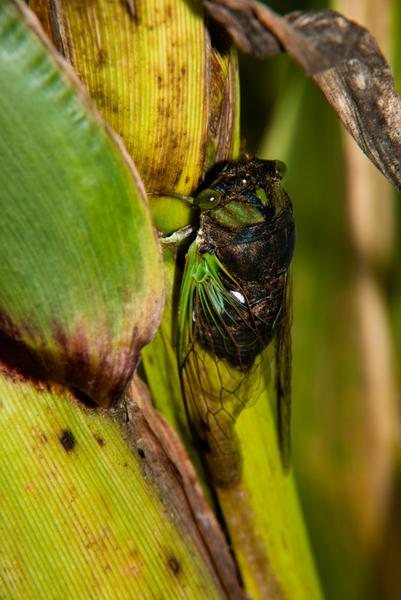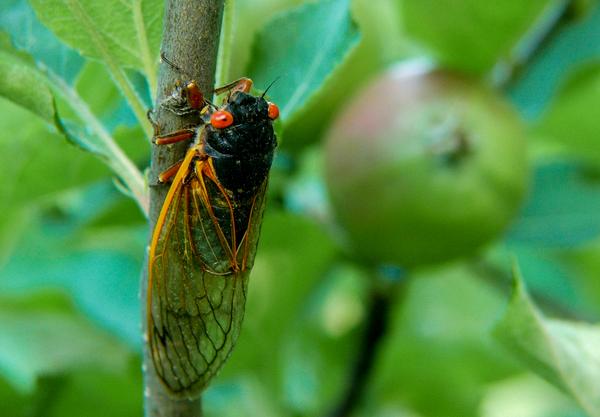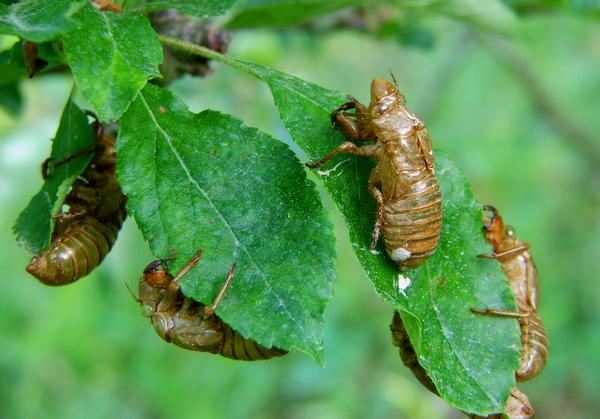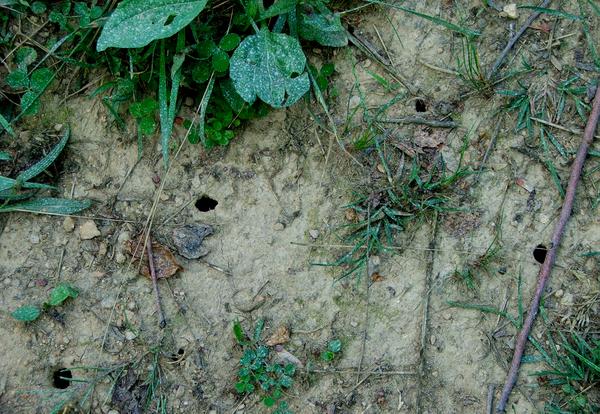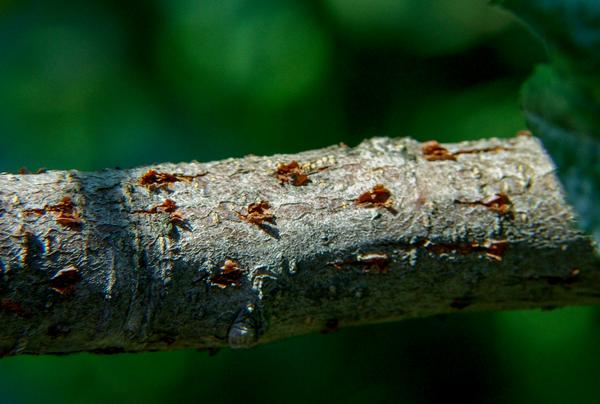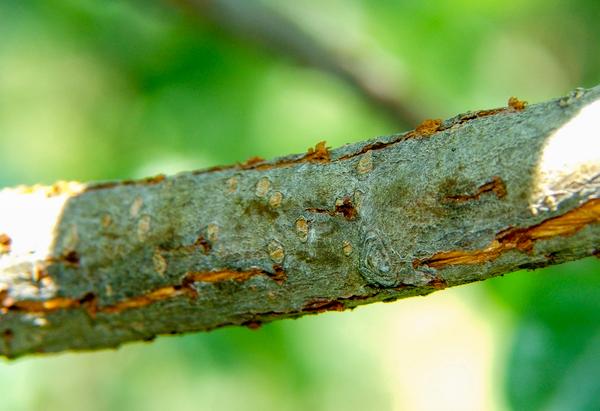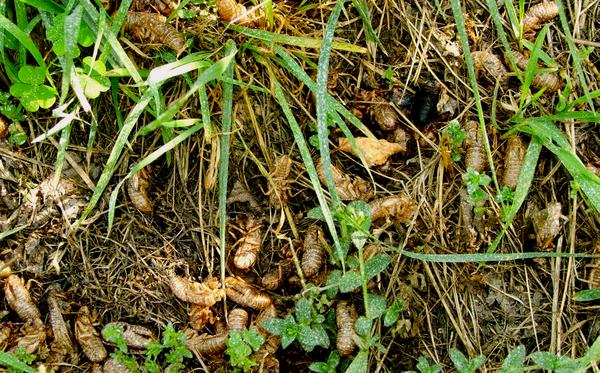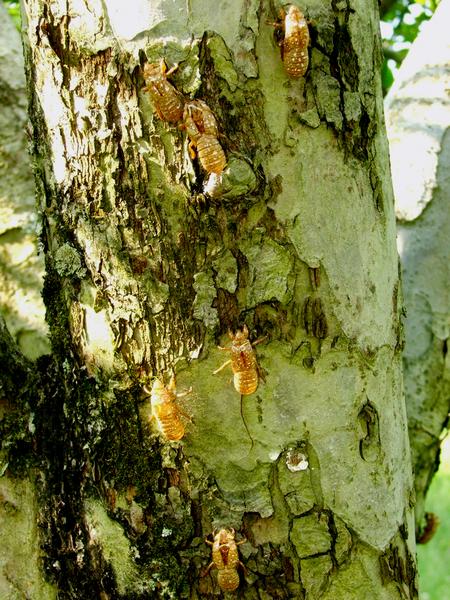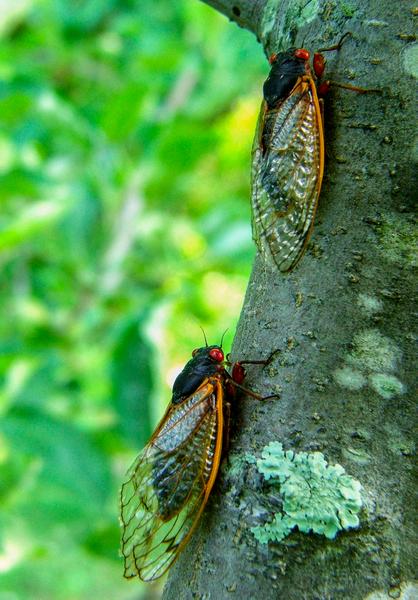Background and Description
Many species of annual and periodical cicadas (family Cicadidae) are native to North America, though neither type is a significant threat to Southeastern orchards except perhaps during a heavy periodical emergence year. Growers should avoid planting new trees when a 13- or 17-year emergence is imminent.
All adult cicadas are large, heavy, wedge-shaped insects. Periodical cicadas are black with red eyes, red legs, and red wing veins, and are about 3/4 to 1 1/4 inch (19 to 32mm) long. Annual cicadas (aka "dog-day cicadas") are generally larger - about 1 3/4 inches (44mm) long - and are dark green to black with green wing veins. Nymphs resemble adults but lack wings, and eggs are shaped like rice and deposited in slits the cicada makes in twigs, branches, and trunks.
Life cycle
Annual cicadas emerge in July and August, begin singing conspicuously, mate, and start laying eggs about 2 weeks after emergence. Over the next 30 days, each female can lay 400 to 500 eggs in groups of 10 to 25. Eggs hatch around 1 1/2 to 2 1/2 months later, then the first-instar nymphs fall to the ground and begin feeding on roots under the soil. Fully developed nymphs will emerge 2 years later and molt into adults.
Periodical cicadas have a similar above-ground life cycle, although they emerge much earlier in the year - usually in May, 2 to 4 weeks after petal fall. They generally appear in much larger numbers than annual cicadas and the drone of their singing may be heard from miles away. At the end of the season, the next generation of nymphs moves underground and remains there for either 13 or 17 years. There are 30 broods of periodical cicadas in the eastern US, with broods I-XVII being the 17-year variety and occurring primarily in the Northeast, and broods XVIII-XXX emerging every 13 years and occuring mainly in the South. However, brood ranges overlap, and in the southern Appalachian region there are both 13- and 17-year cicadas.
Damage
Cicadas make 1/8 to 3/8 inch (2.5 to 10mm) slits in branches and bark in which to lay their eggs. Damage caused by the typical small numbers of annual cicadas does not significantly harm mature trees, but young trees may be weakened or killed by the large numbers of oviposition scars created by an outbreak of periodical cicadas.
Nymphs may also weaken young trees by feeding on their roots, but a very high population is necessary for the damage to be significant.
Monitoring and Control
The best way to avoid extensive cicada damage is to avoid planting new trees when a large periodical emergence is expected within the next 2 to 3 years. In small blocks, existing young trees can be protected with netting that has a 1/4 inch (6.5mm) or finer mesh. Netting should be set up when cicadas are first heard singing and left up for the duration of adult activity. In some cases insecticides may be used to reduce damage, although frequent applications will be necessary if cicadas are continually entering the orchard from outside.
During heavy emergence years, it is best to schedule summer pruning after the majority of eggs have been laid but before they have hatched. By waiting until egg-laying is finished, the damage will be spread over the largest area possible, and by cutting and destroying branches before eggs hatch, many nymphs will be prevented from entering the ground and feeding on roots.
Publication date: Feb. 23, 2015
N.C. Cooperative Extension prohibits discrimination and harassment regardless of age, color, disability, family and marital status, gender identity, national origin, political beliefs, race, religion, sex (including pregnancy), sexual orientation and veteran status.

